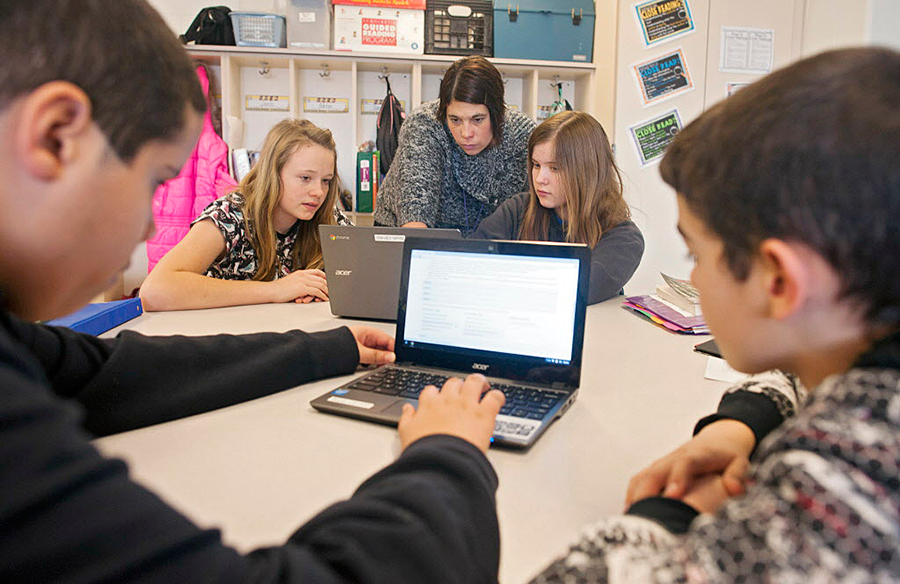US teens slip behind in global math scores. Is that a good benchmark?
Loading...
Even after national educational reforms such as the No Child Left Behind Act and the Common Core, US teens continue to fall behind in math, according to the results of an international exam released Tuesday.
On the Programme for International Student Assessment (PISA), the average math score in the US dropped 11 points in 2015, the largest decrease since 2009, the last year US scores improved on the test given to 72 countries and school systems. US teens remained in the middle of the pack in 2015, ranking 35th in math.
The results have led some education experts to call for a review of how the US school system teaches the subject by comparing it to better performing countries. But others say it might be more beneficial to make state-by-state comparisons.
“International comparisons can be instructive. It is useful to know that teachers in high-scoring Finland are prepared much more thoroughly than teachers in most U.S. states, and that high teacher salaries in Singapore and Taiwan have eliminated shortages in math instruction,” write Martin Carnoy, an education and economics professor at Stanford University, Emma Garcia, an economist at the Economic Policy Institute, and Tatiana Khavenson, a research associate at the National Research University Higher School of Economics in Moscow.
“But too much time in the United States is spent fear-mongering and declaring that our economy is about to tank because of how U.S. schools purportedly stack up against schools in other nation,” they write in Education Week. “If researchers spend more effort on assessing our own states' successes and failures in improving student performance and less on trying to draw lessons from countries with very different social and educational contexts, they are sure to spark a much more productive national educational policy debate than we have had in the past decade.”
Every three years, 15-year-olds take PISA, which was started in 2000 by the Organization for Economics Cooperation and Development (OECD). The two-hour test aims to measure whether students can apply what they’ve learned in school to real-world problems.
About 540,000 students took the test worldwide, 5,700 in the US. Students mostly took the test on computers.
The exam is given to 35 mostly industrialized countries. In some cases, regions stand in for countries, according to Quartz. Taiwan is represented by results in Taipei, and Argentina is represented just by the city of Buenos Aires. Some countries also pay for subnational regions to be tested. The United States, for instance, asked for rankings in Massachusetts and North Carolina.
East Asian countries performed the best. Singapore scored the highest in all three subjects tested – math, reading, and science. In math, students in Singapore scored 564 out of 1,000 points.
US teens performed the worst in math out of the three subjects tested. The average math score was 470, below the test average of 490. The US score was also 11 points lower than it was in 2012 and 18 points lower than in 2009.
“We’re losing ground – a troubling prospect when, in today’s knowledge-based economy, the best jobs can go anywhere in the world,” said US Secretary of Education John B. King Jr. in a statement, as The Wall Street Journal reported. “As the new PISA results show, U.S. students are scoring well behind their peers in top-performing nations.”
But US math scores aren’t all bad. Massachusetts scored 500, above the OECD average of 490.
And just last month, the US saw gains in math scores among fourth- and eighth graders in another test. In the International Mathematics and Science Study (TIMSS), given every four years, US fourth graders ranked 11th in math, and eighth graders ranked ninth.
In years past, results of TIMSS and PISA have led education experts to scrutinize the American education system, making comparisons to the best performing countries. When Finland scored high on PISA in 2000, experts examined why a country, which doesn’t send its children to school until they’re 7, has shorter school days, and gives out less homework, performed the best.
Some experts have consistently warned not to compare the US to other countries. They have said its educational system is too large and too varied.
But other experts have said some lessons can be learned from countries such as Finland. The answer to the Scandinavian countries success may, in part, lie not in the classroom, but on the playground, Pasi Sahlberg, a Finnish educator, wrote for CNN in 2014.
"Play constitutes a significant part of individual growth and learning in Finnish schools," writes Dr. Sahlberg. "Every class must be followed by a 15-minute recess break so children can spend time outside on their own activities."







